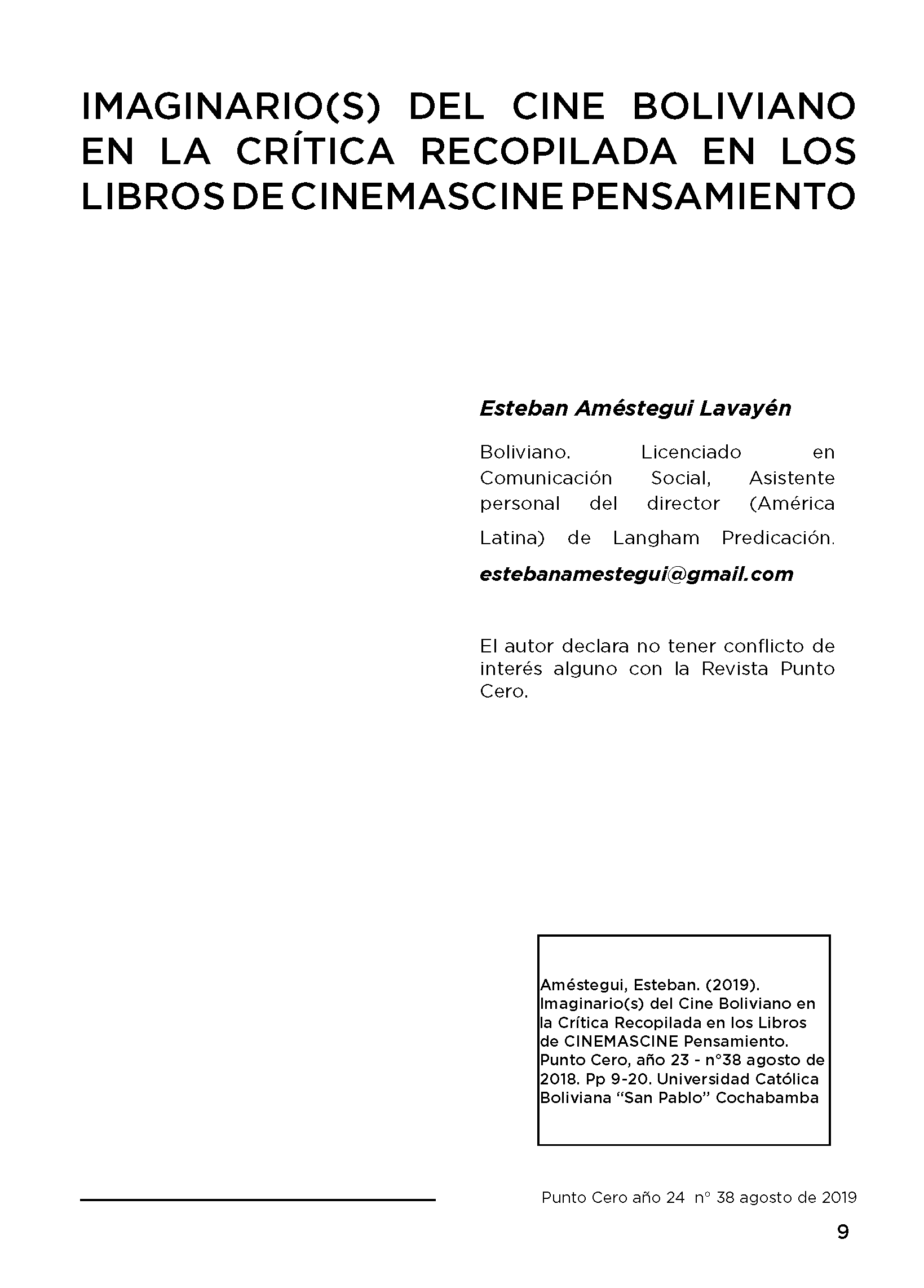Imaginary of Bolivian cine- ma in the critics compiled in the books of Cinemascine
DOI:
https://doi.org/10.35319/puntocero.20193832Keywords:
Imaginary, Bolivian Cinema, Film Criticism, Symbolic Representations, Ideological RepresentationsAbstract
The new generation of critics identifies profound changes in the national cinema since the irruption of the digital era. The themes, the aesthetics, the scenarios, the methods of production and the number of premieres per year are very different to the film age. In this context, critics produce texts that reflect and build the memory of the country’s filmography through printed and digital publications. The purpose of this research is to describe the imaginary of Bolivian cinema in the reviews compiled in books such as “Insurgencias” (2012), “Extravío” (2014) and “Socavones” (2017), from the Cinemascine Pensamiento project. In this regard, a qualitative methodology and a hermeneutic method were used, through content analysis and indepth interviews. The results show the Bolivian cinema as a filmic mirror of reality, product of a collective desire to be represented. It’s also showed as a story of encounter between the father (consecrated Bolivian cinema) and the new generation of filmmakers. From the ideological point of view, it is seen as a space where different problems are raised and finally, as a heterogeneous, plural and unattainable object.
References
Althusser, Louis (1968) “Marxismo y humanismo”. La tradición teórica de Marx. México: Siglo XXI
Álvarez, Juan y JURGENSON, Gayou (2012), “Cómo hacer investigación cualitativa” México DF: Paidós
Belinsky, Jorge (2007), “Lo imaginario: un estudio” Buenos Aires: Nueva Visión
Casseti, Francesco (2000) “Teorías del Cine 1945 – 1990” Madrid, España: Ediciones Cátedra
CINEMASCINE (2012) “Insurgencias: Acercamientos a Insurgentes de Jorge Sanjinés”. La Paz, Bolivia: Cinemascine.
CINEMASCINE (2014) “Extravío: Acercamientos críticos a Olvidados” La Paz, Bolivia: Cinemascine.
CINEMASCINE (2017) “Socavones: textos sobre la obra de Socavón Cine” La Paz, Bolivia: Cinemascine.
CINEMASCINE (2018) “Memoria Jornadas de Cine Boliviano: la mirada cuestionada”. La Paz, Bolivia: Cinemascine.
Espinoza, Santiago y Laguna, Andrés (2009). “El cine de la Nación Clandestina”. Bolivia: Editorial Gente Común
Hernández, Roberto, fernández, Carlos y baptista, Pilar (2014) “Metodología De La Investigación: Roberto Hernández Sampieri, Carlos Fernández Collado Y Pilar Baptista Lucio. 6a. ed”. México D.F.: Mc-Graw-Hill
Katamaya, Roberto (2014) “Introducción a la Investigación Cualitativa: Fundamentos, métodos, estrategias y técnicas” Lima: Fondo Editorial de la UIGV
Kluge, Alexander (2014) “120 historias de cine” Buenos Aires, Argentina: Caja negra.
La Ferla, Jorge (2009) “Cine (y) Digital. Aproximaciones a posibles convergencias entre el cinematógrafo y la computadora” Buenos Aires, Argentina: Ediciones Manantial SRL
Mariaca, Guillermo y Souza, Mauricio (2014) “Cine boliviano. Historia, directores y películas” La Paz, Bolivia. Imprenta de la Facultad de Humanidades y Ciencias de la Educación, Universidad Mayor de San Andrés.
Mesa, Carlos (2018) “Historia del cine boliviano 1897 – 2017” La Paz, Bolivia: Plural Editores
Susz, Pedro (2014) “40/24 papeles de cine, Cine Boliviano / Cine y teoría en América Latina Vol. 1” La Paz, Bolivia: Plural Editores.
Taylor, Sj y Bogdan R (1987) “Introducción a los métodos cualitativos de investigación” Buenos Aires: Ediciones Paidós Ibérica.

Downloads
Published
How to Cite
Issue
Section
License
Copyright (c) 2019 Revista Punto Cero

This work is licensed under a Creative Commons Attribution-NonCommercial 4.0 International License.








